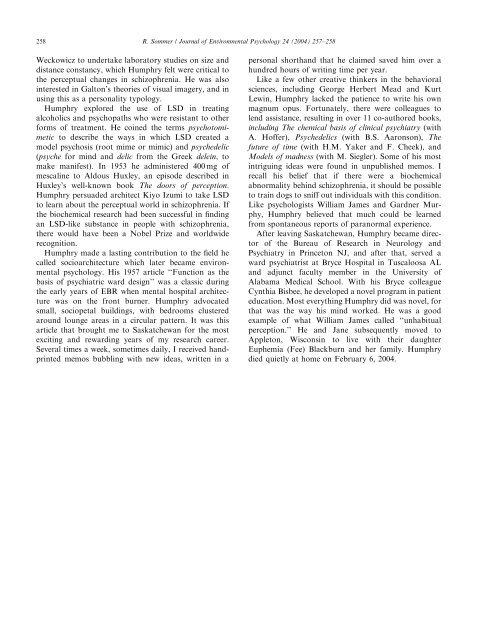In memoriam: Humphry Osmond - Shroomery
In memoriam: Humphry Osmond - Shroomery
In memoriam: Humphry Osmond - Shroomery
Create successful ePaper yourself
Turn your PDF publications into a flip-book with our unique Google optimized e-Paper software.
258<br />
Weckowicz to undertake laboratory studies on size and<br />
distance constancy, which <strong>Humphry</strong> felt were critical to<br />
the perceptual changes in schizophrenia. He was also<br />
interested in Galton’s theories of visual imagery, and in<br />
using this as a personality typology.<br />
<strong>Humphry</strong> explored the use of LSD in treating<br />
alcoholics and psychopaths who were resistant to other<br />
forms of treatment. He coined the terms psychotomimetic<br />
to describe the ways in which LSD created a<br />
model psychosis (root mime or mimic) and psychedelic<br />
(psyche for mind and delic from the Greek delein, to<br />
make manifest). <strong>In</strong> 1953 he administered 400 mg of<br />
mescaline to Aldous Huxley, an episode described in<br />
Huxley’s well-known book The doors of perception.<br />
<strong>Humphry</strong> persuaded architect Kiyo Izumi to take LSD<br />
to learn about the perceptual world in schizophrenia. If<br />
the biochemical research had been successful in finding<br />
an LSD-like substance in people with schizophrenia,<br />
there would have been a Nobel Prize and worldwide<br />
recognition.<br />
<strong>Humphry</strong> made a lasting contribution to the field he<br />
called socioarchitecture which later became environmental<br />
psychology. His 1957 article ‘‘Function as the<br />
basis of psychiatric ward design’’ was a classic during<br />
the early years of EBR when mental hospital architecture<br />
was on the front burner. <strong>Humphry</strong> advocated<br />
small, sociopetal buildings, with bedrooms clustered<br />
around lounge areas in a circular pattern. It was this<br />
article that brought me to Saskatchewan for the most<br />
exciting and rewarding years of my research career.<br />
Several times a week, sometimes daily, I received handprinted<br />
memos bubbling with new ideas, written in a<br />
ARTICLE IN PRESS<br />
R. Sommer / Journal of Environmental Psychology 24 (2004) 257–258<br />
personal shorthand that he claimed saved him over a<br />
hundred hours of writing time per year.<br />
Like a few other creative thinkers in the behavioral<br />
sciences, including George Herbert Mead and Kurt<br />
Lewin, <strong>Humphry</strong> lacked the patience to write his own<br />
magnum opus. Fortunately, there were colleagues to<br />
lend assistance, resulting in over 11 co-authored books,<br />
including The chemical basis of clinical psychiatry (with<br />
A. Hoffer), Psychedelics (with B.S. Aaronson), The<br />
future of time (with H.M. Yaker and F. Cheek), and<br />
Models of madness (with M. Siegler). Some of his most<br />
intriguing ideas were found in unpublished memos. I<br />
recall his belief that if there were a biochemical<br />
abnormality behind schizophrenia, it should be possible<br />
to train dogs to sniff out individuals with this condition.<br />
Like psychologists William James and Gardner Murphy,<br />
<strong>Humphry</strong> believed that much could be learned<br />
from spontaneous reports of paranormal experience.<br />
After leaving Saskatchewan, <strong>Humphry</strong> became director<br />
of the Bureau of Research in Neurology and<br />
Psychiatry in Princeton NJ, and after that, served a<br />
ward psychiatrist at Bryce Hospital in Tuscaloosa AL<br />
and adjunct faculty member in the University of<br />
Alabama Medical School. With his Bryce colleague<br />
Cynthia Bisbee, he developed a novel program in patient<br />
education. Most everything <strong>Humphry</strong> did was novel, for<br />
that was the way his mind worked. He was a good<br />
example of what William James called ‘‘unhabitual<br />
perception.’’ He and Jane subsequently moved to<br />
Appleton, Wisconsin to live with their daughter<br />
Euphemia (Fee) Blackburn and her family. <strong>Humphry</strong><br />
died quietly at home on February 6, 2004.












